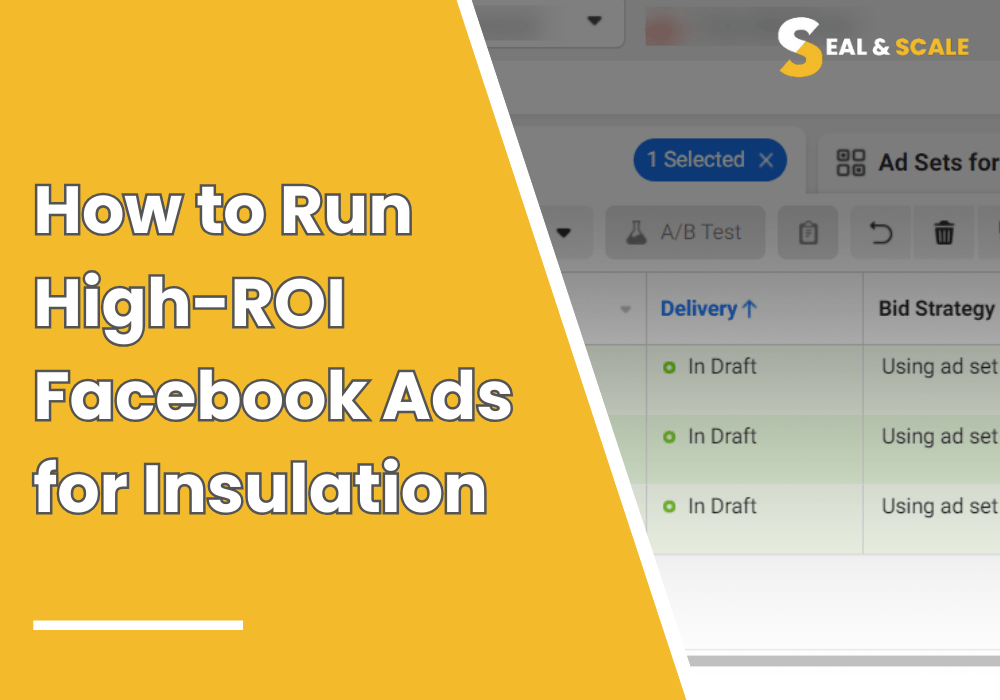How to Run High-ROI Facebook Ads for Insulation
- September 4, 2025

How to Run High-ROI Facebook Ads for Insulation Services
Facebook is still one of the best places to find new customers for insulation work. Homeowners spend hours scrolling daily, and the platform gives you precise tools to reach the right people in your service area. But just running ads isn’t enough, you need a plan that brings in qualified leads without draining your budget.
This guide shows insulation contractors and marketers how to run high-ROI Facebook Ads for insulation services. You’ll learn how to set up tracking, target local homeowners, design a funnel that converts, and improve lead quality so your ad spend produces real jobs.
What High ROI Looks Like for Insulation Ads
Return on investment means different things to different businesses. For insulation, a “good” ROI often comes down to three numbers:
- Cost per lead (CPL): How much you pay per form fill, call, or booked inspection.
- Qualified CPL (CPLQ): The cost once you filter out renters, tire-kickers, or out-of-area leads.
- Return on ad spend (ROAS): The revenue from insulation projects compared to what you spent on ads.
For example, if you spend $800 on ads and close $6,000 in insulation jobs, your ROAS is 7.5x. The key is to track not just leads, but how many become paying customers.
Tracking That Protects Your Budget
Before you run ads, set up your tracking tools. If you don’t, you’ll be guessing which ads work.
- Meta Pixel: Place it on your website or landing page to track visits, form fills, and calls.
- Conversion API (CAPI): A server-side connection that helps you keep accurate tracking after Apple’s iOS privacy updates.
- Offline events: Upload closed jobs into Ads Manager so Facebook can learn which leads turned into sales.
Also connect your Facebook Lead Ads or landing page forms to a CRM. Tools like Zapier or LeadsBridge can push leads straight to your sales team, so no one slips through the cracks.
Local Targeting That Brings in Homeowners
Insulation is local work. There’s no need to waste ad dollars on people who live 100 miles away.
Here’s how to target smartly:
- Geo radius or ZIP codes: Keep your ads inside your service area.
- Homeowner-focused interests: Energy efficiency, home improvement, HVAC, or sustainability.
- Custom audiences: Upload past customer lists, website visitors, or video viewers.
- Lookalike audiences: Build new audiences that resemble your best customers.
- Exclusions: Filter out renters and people outside your service area.
This mix keeps your ads in front of homeowners who are more likely to hire you.
A Simple Funnel That Converts
The highest ROI comes from building a funnel instead of pushing one ad to everyone. Think of it as a three-step path:
Awareness (Top of Funnel)
- Run short videos showing energy loss in a drafty attic.
- Share before-and-after photos of upgraded homes.
Consideration (Middle of Funnel)
- Offer a free energy audit or thermal camera inspection.
- Share customer testimonials or quick tips on saving power.
Conversion (Bottom of Funnel)
- Push strong offers: seasonal discounts, financing options, or rebates.
- Use clear calls-to-action like “Book Your Free Attic Check Today.”
By guiding prospects step by step, you filter out low-intent clicks and focus on those ready to buy.
Offers That Attract Insulation Leads
Generic ads rarely work in home services. You need an offer that speaks to homeowners’ pain points. Here are proven angles:
- Lower energy bills: “Save up to 30% on heating and cooling costs.”
- Comfort upgrade: “Stop drafts and hot rooms with proper attic insulation.”
- Health angle: “Cleaner, safer air with new insulation.”
- Limited-time bonus: “Book by [date] and get a free attic inspection.”
When possible, highlight rebates, financing, or warranties. These give hesitant homeowners one more reason to take action.
Creative That Stops the Scroll
The ad creative is what homeowners notice first. For insulation ads, visuals make all the difference.
- Videos: Show thermal camera scans that reveal where energy is leaking.
- Before/after photos: Attic shots or crawlspace upgrades.
- Carousel ads: Display different types of insulation projects (attic, wall, crawlspace).
- Copy templates:
- “Tired of high energy bills? Our free attic check shows you where you’re losing money.”
- “Keep your home cool this summer and warm this winter—call today.”
- “Tired of high energy bills? Our free attic check shows you where you’re losing money.”
Keep videos short (15–30 seconds) and refresh creatives every month to avoid ad fatigue.
Lead Quality Comes First
Leads that never answer the phone drain your ROI. The solution is focusing on lead quality, not just volume.
- High-intent lead forms: Add custom questions like “Do you own your home?”
- Routing leads: Send them directly to a sales rep or booking system.
- Speed-to-lead: Call within 5 minutes of the form submission.
- CRM automation: Trigger texts or emails right after the lead submits.
This process filters out renters and ensures you connect with serious prospects before they move on.
Seasonal Targeting for Better Timing
Insulation demand shifts with the seasons. Align your ads with homeowner needs:
- Summer: Focus on keeping homes cool and lowering AC bills.
- Winter: Highlight draft prevention, warmth, and lower heating costs.
- Extreme climates: Push urgency around comfort and safety.
You can also retarget homeowners who clicked on past ads with updated seasonal offers.
Smart Budgeting and Scaling
Start small and grow as you see results.
- Daily budgets: Begin with $20–$50 per ad set.
- Bid strategies: Test lowest cost vs. cost cap bidding.
- Frequency: Watch how often people see your ads. Too much exposure can raise costs.
- Scaling: Duplicate winning ad sets, expand geo areas, or build new lookalikes.
Never dump all your budget into one ad. Spread it across a few tests, then back the winners.
Landing Pages That Convert
If you use landing pages instead of lead forms, make sure they’re built to convert:
- Clear headline that matches the ad.
- One strong call-to-action (book now, call now).
- Trust signals like reviews, badges, or financing options.
- Fast loading speed, especially on mobile.
- Sticky phone number or form button.
Consistency between the ad and landing page builds trust and keeps homeowners from bouncing.
How to Keep Improving Results
Your ads won’t be perfect on day one. Build a habit of reviewing and improving.
- Weekly: Check CPL and lead quality. Replace tired creatives.
- Bi-weekly: Compare audience performance.
- Monthly: Look at attribution models, conversion rates, and budgets. Add at least two new creatives per month.
Treat this as ongoing maintenance. Just like insulation work, regular check-ups make everything perform better.
Real Example of Insulation Ads in Action
One insulation contractor ran a campaign using a simple funnel:
- Video awareness ad: Showed a thermal scan of heat escaping from an attic.
- Middle-of-funnel ad: Invited viewers to claim a free inspection within a 30-mile radius.
- Conversion ad: Followed up with a limited-time $500 rebate for new attic insulation.
This structure brought in steady leads at a cost of under $25 each, and the company closed several high-ticket jobs in the first 60 days.
Conclusion
Running Facebook Ads for insulation can be one of the fastest ways to fill your pipeline with qualified leads, if you do it right. Focus on local targeting, build a funnel, track everything, and put lead quality above all else.
Start with small budgets, test different offers and creatives, and keep improving based on real numbers. With the right setup, your Facebook ads won’t just bring in clicks, they’ll bring in booked jobs that pay for themselves many times over.
Digital Marketing Agency for Crawl Space Repair Contractors
© Copyright Seal and Scale 2025. All Rights Reserved
